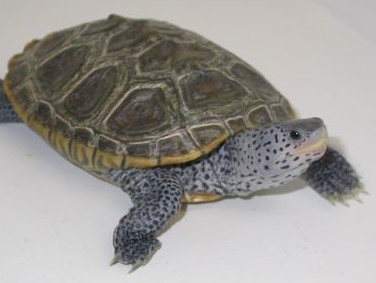
It’s the end of May and you know what that means – it’s the end of the diamondback terrapin’s turn as our Animal of the Month. We hope you enjoyed our tweets about this unusual turtle who can survive in both salt and fresh water. In case you missed any of our tweets during the month, you can refer to the following summary. Did you know?:
- The diamondback terrapin (Malaclemys terrapin) is an aquatic turtle that has seven different sub-species, including the northern diamondback terrapin and the mangrove diamondback terrapin.
- Diamondback terrapin? If they’re turtles, why not call them diamondback turtles? In Commonwealth countries and the U.S., terrapin was a common word for turtle until the latter part of the 20th century.
- These days, the word “terrapin” has fallen out of favour to describe most turtles and is mostly used specifically for diamondback terrapins and their sub-species.
- Diamondback terrapins are native to the coastal areas of the eastern and southern United States, stretching from Massachusetts down around the Florida panhandle to Texas.
- There is also a population of diamondback terrapins which is now established in to a small area in eastern Bermuda. But, for a change, humans aren’t responsible for introducing them to the island nation.
- It’s believed the diamondback terrapins migrated to Bermuda on their own, creating a bit of a mystery as diamondback terrapins are not known for making long migrations and tend to live close to the shoreline.
- Among turtles native to North America, diamondback terrapins are unusual in that they can survive in both fresh water and salt water.
- In the wild, diamondback terrapins live in brackish water, which is a mixture of fresh and salt water. They have a gland near their eyes which allows them to “cry” out excess salt from their bodies.
- The ability to survive in both fresh and salt water gives the diamondback terrapin a competitive edge over other turtles when it comes to habitat and food.
- The diamondback terrapin is a medium-sized turtle and is so named because of the diamond-shaped patterns on the upper shell, which is called a carapace.
- The skin of diamondback terrapins is typically a grey-whitish colour with a pattern of streaks or spots. The carapace is grey and can have some yellow tones on the scutes (the bony plates on the shell).
- Diamondback terrapins are sexually dimorphic, meaning there are physical differences between males and females.
- Female diamondback terrapins are much larger than the males. Females are usually around 22 cms (9 inches) in shell (carapace) length, while males are usually around 12 cms (5 inches) in length.
- Female diamondback terrapins also have shorter tails, taller upper shells and wider heads than their male counterparts.
- As the diamnondback terrapin is our Animal of the Month, we would be remiss if we didn’t mention that May 23rd is World Turtle Day.
- World Turtle Day was started in 2000 by American Tortoise Rescue to raise awareness about the world’s turtles and tortoises and their environments. It is celebrated every May 23rd.
- As with keeping any animal in captivity, keeping a diamondback terrapin is a long-term commitment. With proper care, diamondback terrapins can live between 25-to-40 years.
- Always wash your hands after handling any tortoise or turtle – including diamondback terrapins – because of concerns about the Salmonella bacterium.

